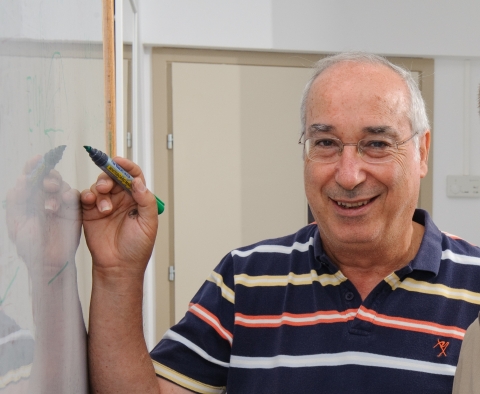Epic science
Homer’s Odyssey, through the lens of astronomy
Features

Science can reveal much about the world in which we live, but can also yield fascinating insights about how living people–in various times and cultures–have experienced the world.
This meeting point between science and the humanities is the focus of a unique entity on Israel’s academic landscape: the Braginsky Center for the Interface between Science and the Humanities at the Weizmann Institute of Science.
Established in 2010 by Rene and Susanne Braginsky, the Center supports research that inhabits the border area between the exact sciences and fields such as psychology, literature, religion, history, language and the arts. It encourages out-of-the-box, cross-disciplinary initiatives. One physicist funded by the Center developed a method for identifying individual authorship in ancient cuneiform tablets based on how a stylus was pressed into wet clay. A systems biologist revealed quantitative data about the placebo effect in Western medicine, as well as supernatural shamanism in tribal cultures.
Since its inception, the Braginsky Center has been directed by Prof. Itamar Procaccia, a member of the Institute’s Department of Chemical Physics who is a pioneering theorist in the area of physics of complex systems. A winner of the Israel Prize in Physics (2009) whose many additional honors include being appointed “knight of the realm” by the Presidents of both Italy and Brazil, Prof. Procaccia’s contributions include the co-development of algorithms used for identifying, quantifying, and analyzing chaotic dynamics; the formulation of a non-linear language for describing the fractal patterns seen throughout the natural world from eroding coastlines to snowflakes; and theoretical constructs for understanding both turbulent fluids and amorphous solid materials.
A scientific odyssey
In a “classic” example of the Braginsky Center’s raison d’être, Prof. Procaccia recently demonstrated how quantitative techniques can be applied to cultural artifacts, revealing deep insights about life in the ancient world.

Prof. Itamar Procaccia
In a public lecture focusing on previously identified astronomical elements in The Odyssey–one of two epic Greek poems attributed to Homer–Prof. Procaccia explained how, based on multiple clues, a celestial event described in the text could be positively identified in the historical astronomical record.
“Odysseus, the hero of Homer’s epic poem, has long been associated with Helios, a titan who, in Greek mythology, was the personification of the sun,” Prof. Procaccia says. He went on to explain how a high level of temporal specificity in the ancient text, as well as references to the zodiac and to astronomical phenomena–all of which had been noted by other researchers–make it possible to identify Odysseus’ journey as a mythic retelling of the sun’s shifting placement in the visible sky in relation to the moon.
“The story’s climax occurs when Odysseus returns home after 19 years–matching the time that passes between each successive total solar eclipse. Sure enough, as described in the poem, on that day the sun was ‘obliterated’ from the sky,” he says. “Moreover, Odysseus didn’t stay home, but like an eclipse, stayed for a single day, then left town. The linking of the epic journey with a specific event begs two related questions: which solar eclipse does the text describe, and when exactly did Odysseus come home? This is the question I set out to answer, using scientific, computational techniques.”
In his lecture, Prof. Proccacia led his audience–consisting of students, faculty, and members of the general public–through his sleuthing process. He started with a comprehensive set of dates on which a total solar eclipse is known to have occurred in ancient times. He then subjected this list of dates to a rigorous computerized analysis to identify which dates fulfilled all the other limiting factors in the text. When the number crunching was complete, Prof. Procaccia had proved that the “sun-obliterating” event that marked Odysseus’ homecoming could only have happened in 1,178 BC. On April 16, to be exact.
Others had previously identified the astronomical content in the Odyssey–including a team of researchers who, in 2008, published their findings in the Proceedings of the National Academy of Sciences. The PNAS article, which supported a link between the Homer’s epic poem and a solar eclipse, built upon the earlier work of astronomers who calculated that an eclipse had taken place on April 16th, 1,178 BC, ten years before the sack of Troy. Prof. Procaccia’s lecture demonstrated how his own close reading of the text revealed relevant clues which, with the help of a computer program, confirmed this date. In addition, he showed how “textual archaeology” makes it possible to catch a fascinating glimpse of what may have inspired star-related myths passed down, via storytellers, in pre-literate society.
“In the ancient world there was no electricity, and people were intimately familiar with how the night sky changed over time,” he says. “The heavens were a backdrop for grand drama, in which people would gather at the end of a hard day, and listen to stories that explained the changes they observed. Even if they were unaware of the significance of all the detailed astronomical data in the epic poems, generations of storytellers succeeded in transmitting it forward, until it was written down. This is the double treasure of Homer’s Odyssey: from a humanities perspective we can appreciate it as a work of literature, while, as scientists, we can use quantitative tools to mine the text for new discoveries.”
Prof. Procaccia's research is supported by the Minerva Center for Nonlinear Physics of Complex Systems which he heads; the Braginsky Center for the Interface between Science and the Humanities which he heads; and the Richard F. Goodman Yale/Weizmann Exchange Program. He is incumbent of the Barbara and Morris L. Levinson Chair in Chemical Physics.








